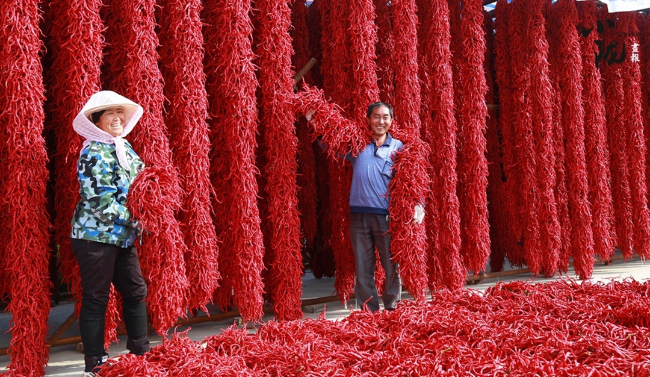Gangu chili, a culinary treasure from the Loess Plateau

Farmers sort out chilies in Gangu county, Tianshui, Gansu province. [Photo provided to gogansu.com]
Nestled upstream of the Wei River, Gangu county, located in the southeastern part of Gansu province, is shrouded in mystery by the Loess Plateau to the north and the Qinling Mountains to the south. The history of chili cultivation in this region dates back over 400 years. During the late Ming and early Qing dynasties, chili from Gangu county gained a reputation as a royal tribute, earning it the title of "Hometown of Chili" throughout Gansu province.
Gangu county has a quintessential continental monsoon climate and boasts the following: an average annual temperature of 11.8°C, an effective accumulated temperature of 1850.8°C, an annual precipitation of 546 millimeters, an average annual sunshine duration of 1903.4 hours, an average annual relative humidity of 64.5%, and a frost-free period of about 215 days. This harmonious blend of well-defined seasons, ample sunlight, moderate precipitation, the absence of extreme summer heat, and gentle winters cultivate an ideal environment. These climatic advantages are instrumental in nurturing the richness and distinctive aromatic profile of the local chili peppers, setting them apart as a product of exceptional quality.
Gangu chili, known for its bright red color, thick flesh, elongated shapes, uniform wrinkles, high drying rate, and rich, fragrant taste, boasts multiple health benefits, including stimulating appetite, spleen health, beautifying and improving eyesight, as well as promoting blood circulation and metabolism. With the highest Vitamin C content reaching up to 92.64 mg/100g, 93 percent higher than similar products, these peppers offer a more suitable taste, with significant antioxidant, whitening, and freckle-removing effects. The iron content peaks at 91 mg/kg, 32.44 percent higher than the average of similar products. The trans-capsaicin content reaches up to 26.2g/kg, 34.55 percent higher than the average of similar products, giving Gangu chili its vivid color and rich aroma, making it stand out among chili products.
With hundreds of years of cultivation experience, chili farmers in Gangu have developed a set of exquisite and unique planting techniques. The local farming model involves fully mulched ridge and furrow dry farming at high altitudes, primarily using farmyard and organic fertilizers, with fewer occurrences of pests and diseases and low frequency of pesticide use, aligning with the standards for green food production.
In 2023, there were 56,000 mu (9225 acres) of land planted to chili peppers in Gangu county. The county has developed more than 100 enterprises, and the production of chili has largely formed an operating system that includes production, storage, processing, transportation, and e-commerce.





 Print
Print Mail
Mail
